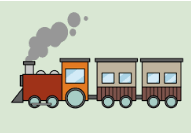Class 2 Exam > Class 2 Questions > The _____ travels on rails.a)trainb)bicyclec...
Start Learning for Free
The _____ travels on rails.
- a)train
- b)bicycle
- c)car
- d)none of these
Correct answer is option 'A'. Can you explain this answer?
Most Upvoted Answer
The _____ travels on rails.a)trainb)bicyclec)card)none of theseCorrec...
The correct answer is option 'A' train.
Explanation:
- A train is a form of transportation that travels on rails. It consists of a series of connected cars or carriages that are pulled by a locomotive or engine.
- Trains are commonly used for long-distance travel, commuting, and transporting goods and materials.
- The use of rails allows trains to travel in a straight line and follow a predetermined route.
- Trains are designed to run on specific types of tracks, which provide stability and support.
- The tracks are made of steel rails that are laid on a bed of ballast, which helps to distribute the weight of the train and provide a stable foundation.
- The wheels of the train fit onto the rails, allowing the train to move forward or backward along the track.
- The use of rails also enables trains to maintain a consistent speed and direction, reducing the risk of accidents or derailments.
- Trains can vary in size and capacity, ranging from small, local commuter trains to large, high-speed trains that can travel at speeds exceeding 300 km/h.
- Some trains are designed for passengers, offering comfortable seating, amenities, and services such as dining cars and sleeping compartments.
- Others are designed for freight transportation, with large cargo cars for carrying goods and materials.
- Trains are an efficient and environmentally friendly mode of transportation, as they can carry a large number of passengers or a significant amount of freight in a single trip.
- In addition to passenger and freight trains, there are also specialized trains for specific purposes, such as subway trains, light rail trains, and monorails.
- Overall, trains are a vital part of transportation infrastructure, providing a reliable and efficient means of travel and cargo transportation.
Explanation:
- A train is a form of transportation that travels on rails. It consists of a series of connected cars or carriages that are pulled by a locomotive or engine.
- Trains are commonly used for long-distance travel, commuting, and transporting goods and materials.
- The use of rails allows trains to travel in a straight line and follow a predetermined route.
- Trains are designed to run on specific types of tracks, which provide stability and support.
- The tracks are made of steel rails that are laid on a bed of ballast, which helps to distribute the weight of the train and provide a stable foundation.
- The wheels of the train fit onto the rails, allowing the train to move forward or backward along the track.
- The use of rails also enables trains to maintain a consistent speed and direction, reducing the risk of accidents or derailments.
- Trains can vary in size and capacity, ranging from small, local commuter trains to large, high-speed trains that can travel at speeds exceeding 300 km/h.
- Some trains are designed for passengers, offering comfortable seating, amenities, and services such as dining cars and sleeping compartments.
- Others are designed for freight transportation, with large cargo cars for carrying goods and materials.
- Trains are an efficient and environmentally friendly mode of transportation, as they can carry a large number of passengers or a significant amount of freight in a single trip.
- In addition to passenger and freight trains, there are also specialized trains for specific purposes, such as subway trains, light rail trains, and monorails.
- Overall, trains are a vital part of transportation infrastructure, providing a reliable and efficient means of travel and cargo transportation.
Free Test
FREE
| Start Free Test |
Community Answer
The _____ travels on rails.a)trainb)bicyclec)card)none of theseCorrec...
Train is a thing. It is a common noun.


|
Explore Courses for Class 2 exam
|

|
Question Description
The _____ travels on rails.a)trainb)bicyclec)card)none of theseCorrect answer is option 'A'. Can you explain this answer? for Class 2 2025 is part of Class 2 preparation. The Question and answers have been prepared according to the Class 2 exam syllabus. Information about The _____ travels on rails.a)trainb)bicyclec)card)none of theseCorrect answer is option 'A'. Can you explain this answer? covers all topics & solutions for Class 2 2025 Exam. Find important definitions, questions, meanings, examples, exercises and tests below for The _____ travels on rails.a)trainb)bicyclec)card)none of theseCorrect answer is option 'A'. Can you explain this answer?.
The _____ travels on rails.a)trainb)bicyclec)card)none of theseCorrect answer is option 'A'. Can you explain this answer? for Class 2 2025 is part of Class 2 preparation. The Question and answers have been prepared according to the Class 2 exam syllabus. Information about The _____ travels on rails.a)trainb)bicyclec)card)none of theseCorrect answer is option 'A'. Can you explain this answer? covers all topics & solutions for Class 2 2025 Exam. Find important definitions, questions, meanings, examples, exercises and tests below for The _____ travels on rails.a)trainb)bicyclec)card)none of theseCorrect answer is option 'A'. Can you explain this answer?.
Solutions for The _____ travels on rails.a)trainb)bicyclec)card)none of theseCorrect answer is option 'A'. Can you explain this answer? in English & in Hindi are available as part of our courses for Class 2.
Download more important topics, notes, lectures and mock test series for Class 2 Exam by signing up for free.
Here you can find the meaning of The _____ travels on rails.a)trainb)bicyclec)card)none of theseCorrect answer is option 'A'. Can you explain this answer? defined & explained in the simplest way possible. Besides giving the explanation of
The _____ travels on rails.a)trainb)bicyclec)card)none of theseCorrect answer is option 'A'. Can you explain this answer?, a detailed solution for The _____ travels on rails.a)trainb)bicyclec)card)none of theseCorrect answer is option 'A'. Can you explain this answer? has been provided alongside types of The _____ travels on rails.a)trainb)bicyclec)card)none of theseCorrect answer is option 'A'. Can you explain this answer? theory, EduRev gives you an
ample number of questions to practice The _____ travels on rails.a)trainb)bicyclec)card)none of theseCorrect answer is option 'A'. Can you explain this answer? tests, examples and also practice Class 2 tests.

|
Explore Courses for Class 2 exam
|

|
Signup for Free!
Signup to see your scores go up within 7 days! Learn & Practice with 1000+ FREE Notes, Videos & Tests.























